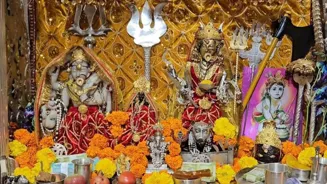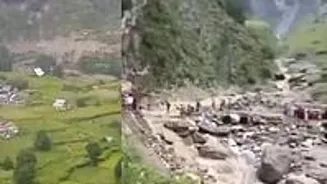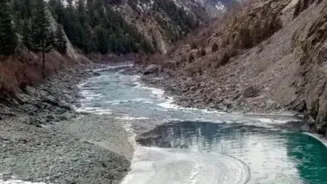Kishtwar: Padder in the district of Kishtwar has much of its own to offer. It is famous for sapphire mines. Padder (Gulabgard) is situated on the bank
of the river Chenab, offering a unique and fascinating sight. It has the unique distinction of having the sacred shrine of Mata Chandi located at an altitude of around 13,500 feet at Machail village, surrounded by high mountains, conifer and evergreen forests mostly dominated by Deodar trees, and attractive meadows adjacent to world-famous sapphire mines located in Suchcham, the last village after Machail. The holy journey to the Machail shrine starts from Chinote Bhaderwah, and the foot journey of about 30 kilometers from Atholi to Machail is a treasure of nature’s glimpses — attractions en route include the holy temple, caves, bubbling streams, springs, greenery, and at some places sharp naked mountains and snow-covered peaks, with night halts at Massu, Chishoti, and Machail village. The worship of the goddess continues at halting stations till late night on all those days. Though now the road has been constructed up to Chishoti, which witnessed the cloudburst on Thursday (August 14), with only 8–10 km of the journey to the temple now undertaken by foot by visiting pilgrims, people still follow the years-old tradition of completing the foot journey to the temple. The most important and impressive aspect of the Machail Yatra is the unique holy mace of the goddess Chandi, which remains ahead of the pilgrims to provide strength and inspiration en route. According to aligned Thakur Kulbir Singh, the goddess Chandi appeared at Machail long, long years ago in the shape of a shila (Pindi). Maa Chandi came here from the ancient place Mindal Battas (HP) to bless the simple, ignorant and helpless people of the Padder area. The main reception stations of the famous Machail Yatra include Bhala, Pul Doda, Premnagar, Thathri, Kishtwar, Atholi, Massu, Chishoti, and Machail, where religious congregations and bhandaras are organized to highlight the importance of religion and the yatra. The distance of about 200 kilometers of the yatra from its base camp up to Gulabgarh Padder is covered by bus in three days. Local people also welcome pilgrims in their houses from the core of their hearts, offer every possible facility within their reach to the pilgrims, and treat them as guests of goddess Chandi. The devotional songs and holy couplets sung and chanted in the local Padre language add to the charm of the holy dances throughout the day. Havans are also performed by devotees for their peace and satisfaction. Also Read: Cloudburst In Jammu And Kashmir's Kishtwar Kills 38, Injures 120; Machail Yatra Suspended
Machail Yatra: Where Shiv and Shakti Meet Amid the Clouds
The Chandi Dham at Machail has the distinction of the simultaneous appearance of Shiv and Shakti. On the one hand, the goddess Chandi (Shakti) blesses her devotees at Machail village, while on the other hand, God Mahadev abruptly appears on the opposite high mountain in the shape of a lingam to provide darshan to the pilgrims on the pious occasion of the Shakti Yatra. The mountain is called Shiv Pahad, which often remains covered with black clouds. This unique union of Shiv and Shakti is found only in Machail and nowhere else in our country. The Lingam also has a unique character of changing its color throughout the day.
As per historical fact, the great General Zorawar Singh, on his way to conquer Gilgit, first bowed his head before the goddess to get her blessings. It is said that the goddess instructed her senior disciple to accompany Zorawar Singh to Gilgit and come back with flying colours, and this fact is reflected in the Aarti of the Machail Yatra.
The Bhote river is a companion all along the journey from Gulabgarh, Atholi to Machail. The work of construction of the road from Gulabgarh Padder to Machail, which is in progress, needs to be sped up so that places like Massu, Garh, Leondi, Deondi, Kundel, Cheshoti, and Hamori are connected. A famous hot water spring at Tatapani has its own significance, where people rush to bathe to get relief from joint pains and skin disorders.
The district and divisional administrations also extend their helping hand in the successful conduct of the Yatra by deputing medical and wireless teams, Yatra officers, volunteers, security staff, and deployment of vehicles for pilgrims to make the Yatra a grand success. The Machail Yatra is becoming more popular day by day.
A Himalayan Pilgrimage into the Heart of Devotion
The Yatra is a large undertaking, spanning about two weeks and culminating with the arrival of hundreds of Trishul-bearing Sadhus, who are accepted wholeheartedly by local people. Chishoti villagers make blankets, and other villages build shelters, cook food, and more.
Outside the Chandi Mata temple, perched on the highest point in the village, are familiar painted carvings of Ravana, Sheshnag, Hanuman, and the eyes of Mahakali. This temple is slightly larger than others and includes Surya the Sun God, Mayravan (a three-headed form of Ravana), and more.
Inside the small temple are two pandits and a group of devotees. As we approach, the earrings of Maha Lakshmi and Saraswati begin to move.
"They are happy," says the pujari, whose forefathers were given the first darshan of Chandi five hundred years ago, describing it as a rare occurrence, though "they are always alert."
I looked inside at the beautiful scene of Lakshmi, Saraswati, Kali, and Chandi, four mother goddesses. Sure enough, their earrings were moving to and fro, whereas all the other dozens of things that could sway in the slightest breeze were perfectly still.
The people of Kishtwar District, particularly of Padder, are now looking forward to the establishment of the Machail Mata Shrine Board on the pattern of the Amarnath Shrine Board and Vaishno Devi Shrine Board so that the Yatra, which takes place every year, could be managed in a better way.
















